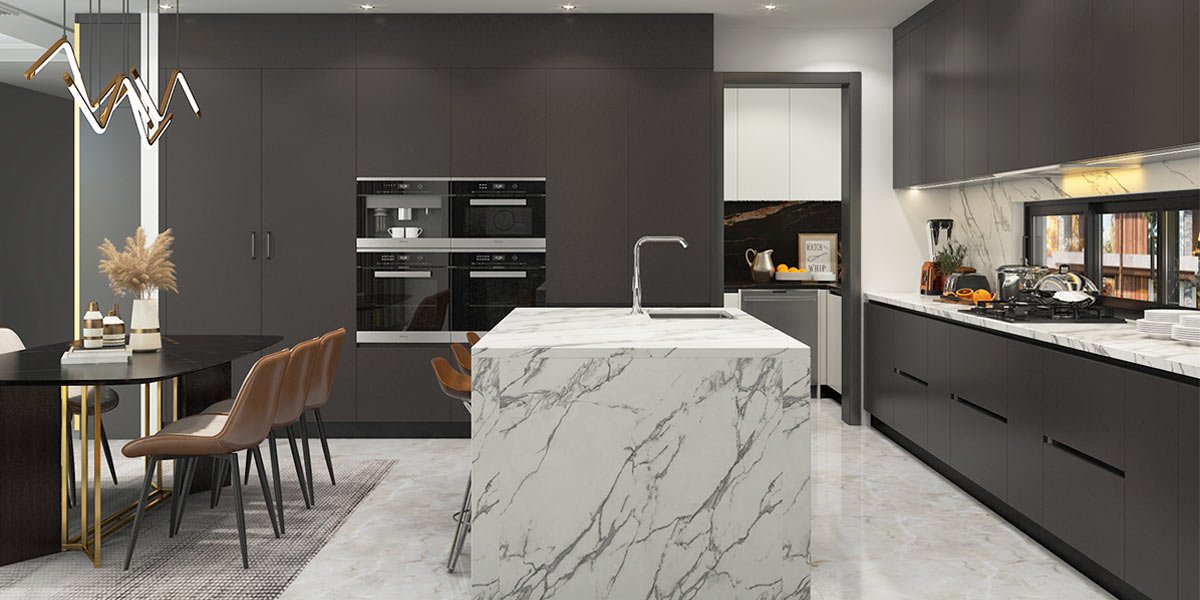Introduction
The kitchen, the heart of the home, is a space where culinary adventures unfold. But beyond the delicious meals that emerge, a crucial decision awaits, choosing between a wet and dry kitchen.
This seemingly simple choice has far-reaching consequences, impacting not just your cooking habits but also your lifestyle and the overall aesthetic of your home.
The Wet Kitchen: Where Passion Meets Functionality
Imagine the symphony of sizzling pans and clinking pots, the aroma of spices filling the air. This is the essence of a wet kitchen, a haven where culinary passion reigns supreme.
Nestled near the dining area, it functions as the central hub for cooking and cleaning, streamlining the culinary workflow.
Equipped with a sink, stove, oven, and an array of appliances, a wet kitchen caters to the diverse demands of the chef.
From whipping up a quick breakfast to crafting elaborate multi-course meals, this versatile space has the tools to transform culinary dreams into reality.
However, the very essence of its function necessitates robust ventilation. Smoke and fumes, while integral to the cooking process, can quickly turn the kitchen into an unpleasant environment.
A powerful exhaust system becomes essential to maintain a comfortable and healthy cooking space.
The Dry Kitchen: A Minimalist Sanctuary for Culinary Preparation
In stark contrast to the vibrant energy of a wet kitchen, the dry kitchen exudes a serene minimalism.
Located near the dining area, it serves as a dedicated space for food preparation and storage.
Here, the focus shifts from cooking to tasks like chopping vegetables, making coffee, and organizing pantry staples.
The design of a dry kitchen prioritizes clean lines and uncluttered surfaces, creating a calming and aesthetically pleasing environment. Built-in cabinets, drawers, and pantry shelves offer ample storage, while sleek countertops provide ample space for food prep.
One of the primary advantages of a dry kitchen is its ease of maintenance. The absence of cooking activities eliminates the need for extensive ventilation, making cleaning a breeze.
This minimalist haven also offers a perfect canvas for self-expression, allowing you to personalize the space with your chosen colors, textures, and decorative accents.
Choosing Your Culinary Home: A Balancing Act
Ultimately, the choice between a wet and dry kitchen hinges on your individual needs and culinary philosophy.
Are you a passionate cook who thrives on the energy and convenience of a centralized cooking space?
Or are you drawn to the minimalist aesthetics and clean lines of a dry kitchen that separates your culinary endeavors from your living space?
For those who find joy in the art of cooking, a wet kitchen may be the perfect fit. Its centralized design and robust functionality ensure an efficient and enjoyable culinary experience.
However, if you prioritize a peaceful and organized kitchen environment, a dry kitchen may be the answer, offering a designated space for food preparation while keeping your living area free of cooking-related clutter.
Beyond Function: Embracing Culinary Harmony
While the wet and dry kitchen offer distinct advantages, both spaces ultimately share the same goal, to foster a love for food and create a space where culinary creativity can flourish.
Regardless of your choice, remember that your kitchen is a reflection of your personal style and tastes.
Embrace the possibilities, personalize your space, and most importantly, enjoy the culinary journey that awaits within its walls.
Faqs
Which kitchen is better, wet or dry?
There is no single “better” option as both wet and dry kitchens offer distinct advantages and cater to different needs.
A wet kitchen is ideal for passionate cooks who appreciate the convenience of centralized cooking and preparation.
In contrast, a dry kitchen suits those who prefer a minimalist design and separate their culinary space from the living area.
What appliances are essential for a wet kitchen?
A well-equipped wet kitchen needs a sink, stove, oven, and exhaust fan. Depending on your cooking habits, you may also consider adding appliances like a dishwasher, microwave, and food processor.
Can a dry kitchen handle heavy cooking?
While not specifically designed for heavy cooking, some dry kitchens can accommodate it with specific modifications.
Installing powerful ventilation systems and choosing appliances with high capacity can help manage the heat and smoke generated during intense cooking sessions.
What are the storage options for a dry kitchen?
Dry kitchens often utilize sleek and minimalist storage solutions like built-in cabinets, drawers, and pantry shelves.
Utilizing vertical space and maximizing corner space are key to optimizing storage in a dry kitchen.
Conclusion
Embracing the duality of wet and dry kitchen spaces allows you to create a culinary haven that perfectly complements your lifestyle and cooking preferences.
Whether you seek the vibrant energy of a wet kitchen or the serene minimalism of a dry one, remember that your kitchen is a space for creativity, joy, and nourishment.
So, explore the possibilities, embrace your culinary spirit, and design a space that inspires you to create delicious memories.







Leave feedback about this Cancel Reply